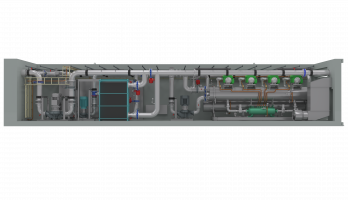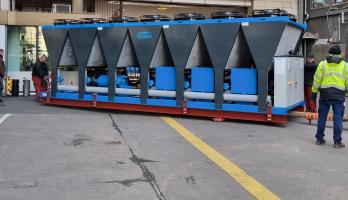
Refrigerants with a future: Mastering the F-Gas Regulation sustainably thanks to ENGIE Refrigeration
By 2030, the European Union aims to reduce emissions of fluorinated greenhouse gases by 70 million tonnes of CO2 equivalent to 35 million tonnes of CO2 equivalent compared to 1990. The F-Gas Regulation makes a key contribution to this by incentivising the use of alternative refrigerants and requiring those responsible to develop new strategies for the cooling and heating supply of tomorrow. Jörn Stiegelmeier, Head of Technology and Development at ENGIE Refrigeration, knows the legal situation very well, not least through his association work at the Bundesindustrieverband Technische Gebäudeausrüstung e. V. (BTGA), and points out future-proof perspectives.
Mr Stiegelmeier, everyone in the industry is talking about the new F-Gas Regulation. Can you summarise the most important milestones of the amendment for our readers?
Jörn Stiegelmeier: First of all, I would like to emphasise: Despite the change in legislation, our customers have no reason to worry about their chillers and heat pumps or the refrigerants they require. Nevertheless, it is important to understand the background in more detail: Originally, the first draft of the F-Gas Regulation was to apply in the European Union until 2030. However, due to the Montreal Protocol, global warming and other environmental factors, a tightening of the regulation was unavoidable. Over the course of 2022, numerous associations as well as the committees influenced the design of the new draft - always with the goal of saving millions of tonnes of CO2 in mind. Unlike the first draft, the new F-Gas Regulation was intended to include medical dosimeters (MDIs), such as asthma sprays. However, as these account for an enormous share of around ten million tonnes of CO2 equivalent of the total quantity and therefore have a greater demand than in stationary refrigeration and air conditioning technology in 2020, several associations warned of a CO2 equivalent shortfall in 2026 or 2027 and of a shortage of refrigerants. The F-Gas Regulation was therefore revised again by October 2023. It was published in the Official Journal of the European Union on 20 February 2024 and will enter into force 20 days later, i.e. on 11 March 2024; its first amendments will take effect from 1 January 2025. Important for our customers: The requirements affect the sale of new machines until 2050.
What key changes are in store for the industry
Jörn Stiegelmeier: In order to create a tangible incentive to reduce CO2 emissions, the new F-Gas Regulation obliges distributors to pay three euros per tonne of CO2 equivalent as a quota fee. As we predominantly use low-GWP refrigerants, this amount is negligible. What is also particularly important for our industry is that fluorinated greenhouse gases can be used until 2049, after which they expire, with the exception of refrigerants listed in Annex II, such as R-1234ze (Annex II refrigerants are not subject to the CO2-equivalent quota limit). Recycled refrigerants are eligible for servicing up to a Global Warming Potential (GWP) of 2,500 from 2026; in the period before this, even more is possible above this GWP value. From 2032, a GWP limit of 750 will apply for servicing, unless the refrigerant used is recycled and reprocessed. And: in 2030 and 2040, those responsible are planning to review the individual measures laid down in the F-Gas Regulation once again. The aim is to ensure that the regulations remain appropriate and do not become too drastic for the phase-out.
And what does this mean in concrete terms for the refrigeration industry?
Jörn Stiegelmeier: This depends on the GWP value of the refrigerant and the capacity range of the machine. If the global warming potential is above 750, ENGIE Refrigeration may use the refrigerants R-134a, R-513A, R-515B and R-1234ze for chillers over twelve kilowatts until 31 December 2026. From 1 January 2027, refrigerants R-513A, R-515B and R-1234ze will be the right choice for new chillers over twelve kilowatts until 2050. For the refrigerant R-1234ze, there are no restrictions imposed by the F-Gas Regulation even after 2050. Refrigerants with a higher GWP may also be used if safety requirements are increased. A GWP value of 2,500 is permitted for all chillers until 1 January 2026 - this includes the refrigerant R-134a.
What affects the refrigerant industry automatically affects the daily work of ENGIE Refrigeration. How does the F-Gas Regulation affect this?
Jörn Stiegelmeier: That depends on the GWP value of the refrigerant and the capacity range of the machine. If the global warming potential is above 750, ENGIE Refrigeration may use the refrigerants R-134a, R-513A, R-515B and R-1234ze for chillers over twelve kilowatts until 31 December 2026. From 1 January 2027, refrigerants R-513A, R-515B and R-1234ze will be the correct choice for new chillers over twelve kilowatts until 2050. Refrigerants with a higher GWP may also be used if safety requirements are increased. A GWP value of 2,500 is permitted for all chillers until 1 January 2026 - this includes the refrigerant R-134a.
What consequences does the amendment have for ENGIE Refrigeration's product portfolio?
Jörn Stiegelmeier: Fortunately, we are flexible and future-proof in both the refrigeration and heating sectors, so we will be able to master the changes together with our customers. For our chillers, the new F-Gas Regulation only means that the refrigerant R-134a will no longer be used from 31 December 2026. From 1 January 2027 until the end of 2050, we will continue to use the highly efficient refrigerants R-513A, R-515B and R-1234ze that we have been using for years. We generally recommend the R-1234ze variant here, as it has the lowest global warming potential and therefore makes a lasting difference on the path to climate neutrality and does not fall under the quota and can therefore also be used after 2050. Above all, because we use it in an oil-free system, which further contributes to energy efficiency.
The regulations are stricter for heat pumps. A distinction is made here between three output ranges: under twelve kilowatts, twelve to 50 kilowatts and over 50 kilowatts. The output range above 50 kilowatts is particularly relevant for ENGIE Refrigeration. With a GWP value above 150, the use of refrigerants R-513A, R-515B and R-1234ze is permitted for heat pumps over 50 kilowatts until 31 December 2029. Meanwhile, from 1 January 2030, the F-Gas Regulation will permit a GWP of up to 150 for heat pumps over 50 kilowatts and therefore, in our case, only the use of the sustainable refrigerant R-1234ze. With increased safety requirements, the refrigerants R-513A or R-515B with a GWP of up to 750 can continue to be used.
Let's take a closer look at the QUANTUM and SPECTRUM series in particular: Which refrigerants come into question here according to the F-Gas Regulation?
Jörn Stiegelmeier: Our newly developed SPECTRUM models can currently be ordered with R-513A, R515B and R-1234ze, and from 1 January 2030 exclusively with R-1234ze. In addition, the F-Gas Regulation allows the QUANTUM to be operated as a heat pump if we design it as a heat pump or use the refrigerant R-1234ze directly. The good news is that, despite the restrictions, our customers continue to benefit from machines that provide both cooling and heating highly efficiently and without increased risk. The decisive factor in the design is whether the chiller or the heat pump function is used throughout the year. Incidentally, our innovative Green Heat Recovery technology falls into the refrigeration sector, meaning that it is not affected by the stricter rules of the F-Gas Regulation for heat pumps.
Europe-wide, ENGIE Refrigeration's product portfolio is therefore secured for the future. What about the international export business?
Jörn Stiegelmeier: The EU directives of the F-Gas Regulation also apply outside European borders: If ENGIE Refrigeration wants to export equipment to another continent, the new F-Gas Regulation states that it is a dedicated machine and must therefore comply with the F-Gas Regulation at the current time of delivery. The overarching aim of those responsible is to also support countries outside the EU on the path to climate neutrality.
Last but not least: How do you personally rate the new F-gas regulation?
Jörn Stiegelmeier: I am pleased that the associations have succeeded in helping to shape the amendment to the F-Gas Regulation in such a way that a distinction is made between capacity and efficiency. As a result, large machines with appropriate refrigerant charges and high performance will be able to continue working efficiently and safely with R-1234ze artificial refrigerants until 2050 and beyond. The high energy efficiency of our oil-free machines also saves CO2 equivalent in electricity consumption and global warming potential. This becomes very clear when looking at the TEWI value, which takes into account the direct and indirect global warming potential. The new legal situation also confirms that it pays to future-proof our own product portfolio from the outset. This is because the choice of refrigerant is not the sole focus when developing our chillers and heat pumps. Quite the opposite: in every single development step, we ensure that our systems are designed to be as energy-efficient and absolutely robust as possible for the refrigeration and heating industry of tomorrow. Our machines are designed to be permanently leak-proof in order to prevent any refrigerant leakage. As is now clear: This strategy pays off in every respect.









